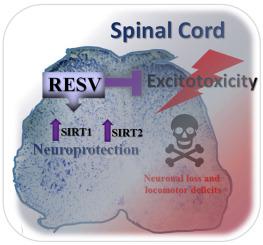当前位置:
X-MOL 学术
›
Neuropharmacology
›
论文详情
Our official English website, www.x-mol.net, welcomes your feedback! (Note: you will need to create a separate account there.)
Resveratrol evokes neuroprotective effects and improves foot stance following kainate-induced excitotoxic damage to the mouse spinal cord
Neuropharmacology ( IF 4.7 ) Pub Date : 2024-03-16 , DOI: 10.1016/j.neuropharm.2024.109906 Benjamín Zylberberg , Martina Poodts , Julieta Roncoroni , M. Florencia Coronel , Graciela L. Mazzone
Neuropharmacology ( IF 4.7 ) Pub Date : 2024-03-16 , DOI: 10.1016/j.neuropharm.2024.109906 Benjamín Zylberberg , Martina Poodts , Julieta Roncoroni , M. Florencia Coronel , Graciela L. Mazzone

|
Excitotoxicity, characterized by over-activation of glutamate receptors, is a major contributor to spinal cord injury (SCI) pathophysiology, resulting in neuronal death and loss of locomotor function. In our previous studies, we showed that excitotoxicity induced by the glutamate analogue kainate (KA) leads to a significant reduction in the number of neurons, providing a model for SCI. Our current objective was to assess the neuroprotective role of resveratrol (RESV), a natural polyphenol, following KA-induced SCI. excitotoxicity was induced by intraspinal injection of KA immediately followed by RESV administration to Balb/C adult male mice. In neonatal mouse spinal cord preparations, excitotoxicity was transiently induced by bath-applied KA, either with or without RESV. KA administration resulted in a significant deterioration in hindlimb motor coordination and balance during locomotion, which was partially reverted by RESV. Additionally, RESV preserved neurons in both dorsal and ventral regions. Sirtuin 2 (SIRT2) immunoreactive signal was increased by RESV, while the selective SIRT1 inhibitor 6-chloro-2,3,4,9-tetrahydro-1H-carbazole-1-carboxamide (EX-527) attenuated RESV neuroprotective effects. These findings suggest that RESV attenuation of excitotoxic-induced neuronal loss and locomotor deficits is mediated, at least in part, through the activation of SIRT1, potentially involving SIRT2 as well. Indeed, our results highlight the potential use of RESV to enhance neuroprotective strategies for SCI.
中文翻译:

白藜芦醇在红藻氨酸诱导的小鼠脊髓兴奋性毒性损伤后产生神经保护作用并改善足部姿势
以谷氨酸受体过度激活为特征的兴奋性毒性是脊髓损伤 (SCI) 病理生理学的主要原因,导致神经元死亡和运动功能丧失。在我们之前的研究中,我们发现谷氨酸类似物红藻氨酸 (KA) 诱导的兴奋性毒性会导致神经元数量显着减少,为 SCI 提供了模型。我们当前的目标是评估白藜芦醇 (RESV)(一种天然多酚)在 KA 诱导的 SCI 后的神经保护作用。通过立即向 Balb/C 成年雄性小鼠脊柱内注射 KA,然后立即给予 RESV 来诱导兴奋性毒性。在新生小鼠脊髓制剂中,无论有或没有 RESV,使用浴液 KA 都会短暂诱导兴奋性毒性。 KA 给药导致运动过程中后肢运动协调性和平衡性显着恶化,RESV 可以部分恢复这种情况。此外,RESV 保留了背侧和腹侧区域的神经元。 RESV 增加了 Sirtuin 2 (SIRT2) 免疫反应信号,而选择性 SIRT1 抑制剂 6-氯-2,3,4,9-四氢-1H-咔唑-1-甲酰胺 (EX-527) 减弱了 RESV 的神经保护作用。这些发现表明,RESV 对兴奋性毒性诱导的神经元损失和运动缺陷的减弱至少部分是通过激活 SIRT1 介导的,也可能涉及 SIRT2。事实上,我们的结果强调了 RESV 增强 SCI 神经保护策略的潜在用途。
更新日期:2024-03-16
中文翻译:

白藜芦醇在红藻氨酸诱导的小鼠脊髓兴奋性毒性损伤后产生神经保护作用并改善足部姿势
以谷氨酸受体过度激活为特征的兴奋性毒性是脊髓损伤 (SCI) 病理生理学的主要原因,导致神经元死亡和运动功能丧失。在我们之前的研究中,我们发现谷氨酸类似物红藻氨酸 (KA) 诱导的兴奋性毒性会导致神经元数量显着减少,为 SCI 提供了模型。我们当前的目标是评估白藜芦醇 (RESV)(一种天然多酚)在 KA 诱导的 SCI 后的神经保护作用。通过立即向 Balb/C 成年雄性小鼠脊柱内注射 KA,然后立即给予 RESV 来诱导兴奋性毒性。在新生小鼠脊髓制剂中,无论有或没有 RESV,使用浴液 KA 都会短暂诱导兴奋性毒性。 KA 给药导致运动过程中后肢运动协调性和平衡性显着恶化,RESV 可以部分恢复这种情况。此外,RESV 保留了背侧和腹侧区域的神经元。 RESV 增加了 Sirtuin 2 (SIRT2) 免疫反应信号,而选择性 SIRT1 抑制剂 6-氯-2,3,4,9-四氢-1H-咔唑-1-甲酰胺 (EX-527) 减弱了 RESV 的神经保护作用。这些发现表明,RESV 对兴奋性毒性诱导的神经元损失和运动缺陷的减弱至少部分是通过激活 SIRT1 介导的,也可能涉及 SIRT2。事实上,我们的结果强调了 RESV 增强 SCI 神经保护策略的潜在用途。



























 京公网安备 11010802027423号
京公网安备 11010802027423号